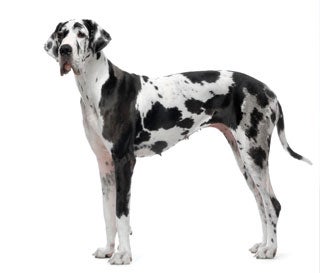Learn about dog breeds
Detailed information & photos on over 190 different breeds
Description
The Great Dane is an easily recognized breed. They are known for being fit and regal in appearance. They are very large dogs and also have an amazing strength. They are built solid and have a reserved temperament. They are often found as companions or watchdogs.
The Great Dane’s head is held high. It is broad with a large rectangular muzzle. The nose is black and prominent. The Great Dane has well set eyes that show a lively nature. The ears in natural state are long and fold over, but can be cropped to stand erect. The overall look of the Great Dane is one of a chiseled and definite structure.
The neck is long and high. It flows into the deep, broad chest with the large rib cage and tucked abdomen. The legs are strong and athletic in appearance. The Great Dane has a slight slope to the back with a long tapered tail that curls up at the hock. The Great Dane’s feet are round with thick pads. They have strong nails. The coat can be light brown to blue in color. It is short and shiny. The Great Dane moves with ease and confidence.
Coat Description
The coat of a Great Dane is short and sleek. It is shiny and close to the body in every area with no excess hair or fluff. The colors will be deep no matter the shade.
History
The Great Dane came from a line of prized and royal dogs in Greece. They were developed into the modern Great Dane in Germany. They were bred for their strength and obedience. They were often used as hunting dogs in the 14th century. Today they are seen in a number of situations, such as work dogs or pets.
Temperament
The Great Dane is a calm dog, which is good considering how large and strong this breed is. They are protective of their family, but will not usually be aggressive. They can be good with children, but at times they forget their large size so they should be supervised with smaller children. They are great companions if they are socialized from an early age. They should be given time with other dogs. Male dogs should be neutered to prevent aggressive behavior that can develop. It should also be raised with other pets to help promote friendship between them.
The Great Dane is a playful dog and will be playful throughout adulthood, not just as a pup. They will need good training to help keep them from getting too rambunctious and to teach them to control themselves in situations.
Health Problems
The Great Dane is prone to some health conditions if not bought from a good breeder. Common problems include gastric torsion or bloat, skin problems, cardiomyopathy, hip dysplasia, CVI or Wobbler’s Syndrome and Von Willebrand’s Disease.
Grooming
The Great Dane is not demanding as far as grooming goes. A good weekly brushing is fine. They can be rubbed down with a cloth to help keep their coat shiny. They do not shed heavily but will lightly shed and may need extra care during those periods of the year. A dry powder shampoo is preferred over a wet bath. A full bath is best left up to a professional since the Great Dane is prone to skin conditions that often result from poor bathing technique. The only other grooming concern is keeping the nails short and trimmed.
Exercise
The Great Dane can take care of his exercise needs on his own if left outside. However, a good exercise routine will help to ensure he is getting the exercise he needs. They are great for jogging or running, but only one in adulthood. Too much hard exercise as a pup can lead to joint problems.
They are usually well behaved indoors and will not act overly hyper. They do love to play, though, so once you get them started you should be aware of this. Playing outside is best unless you have an open space indoors where they can not damage anything. They should be outside at least or a couple hours during good weather. They do not respond well to cold climates so they should never be left outside in colder temperatures or wet conditions.
If they do not get enough exercise the Great Dane can become too excitable and may gain weight. They really need moderate exercise for longer periods of time each day instead of a short burst of exercise.
Training
The Great Dane is easy to train. The biggest obstacle is keeping the dog interested and focused. Since they are so large and strong they can easily choose to do what they want and it is hard for a trainer to stop them. It is important that trust and recognition of the trainer is developed.
They should have obedience training and socialization training. The training methods need to be calm and never rough. If they feel as if they are being punished they will rebel and not listen to anything. Training does need to be firm, but not overboard. They also need to be taught on a leash and not to jump when excited.
Advertise | Privacy Policy | Terms of Use | Contact Us © Copyright 2004-2024 PupCity.com. All rights reserved.
